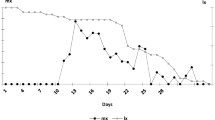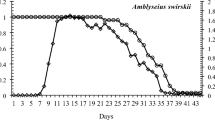Abstract
The predacious mite,Agistemus exsertus Gonz. was reared on 4 types of animal egg diets (eggs ofTetranychus urticae Koch,Eutetranychus orientalis Klein,Brevipalpus pulcher [C. & F.] andBemisia tabaci [Genn.]). Life table parameters of each diet (net reproduction rate [Ro], mean generation time [T], intrinsic rate of increase [rm] and finite rate of increase [erm]) were determined. Eggs ofT. urticae were found to be preferred above other egg diets as food byA. exsertus and promoted a higher rate of oviposition. The intrinsic rate of increase was 0.15 individuals/♀/day; the population multiplied 57.91 times in a generation time of 26.21 days. Rearing on eggs ofB. tabaci exhibited more attractive compared withB. pulcher. The average number of eggs consumed daily by female was 17, 12, 9 and 7 eggs ofT. urticae, E. orientalis, B. tabaci andB. pulcher respectively. In the sex ratio of the progeny, predator females fed inT. urticae andB. tabaci gave rise to more females.
Zusammenfassung
Die RaubmilbeAgistemus exsertus Gonz. wurde im Labor unter Fütterung mit veschiedenen Milben- und Insekteneiern (Tetranychus urticae, Eutetranychus orientalis, Brevipalpus pulcher, Bemisia tabaci) aufgezogen. Die life table-Parameter bei jeder Nahrung (Netto-Reproduktionsrate Ro, mittlere Generationsdauer T, Innere Zuwachsrate rm sowie Gesamt-Zuwachsrate erm) wurden bestimmt. Die Eier vonT. urticae wurden allen anderen Eiern vorgezogen und bewirkten die höchste Eiablege-Rate der Raubmilbe. Die innere Zuwachsrate betrug 0,15 Indiv./♀/Tag. Die Population nahm während der Generationszeit von 26,2 Tagen um das 57,9fache zu. Die Eier vonB. tabaci wurden jenen vonB. pulcher vorgezogen. Die durchschnittliche Zahl der täglich von einem Raubmilben-Weibchen verzehrten Eier betrug 17, 12, 9 und 7 Eier vonT. urticae, E. orientalis, B. tabaci undB. pulcher. Bezüglich des Weibchen-Anteils der Nachkommen brachten Raubmilben-Weibchen bei Fütterung mitT. urticae- undB. tabaci-Eiern die meisten Weibchen hervor.
Similar content being viewed by others
References
Birch, L. C., 1948: The intrinsic rate of natural increase on an insect population. J. Anim. Ecol.17, 15–26.
El-Badry, E. A., 1967. Three new species of phytoseiid mites preying on the cotton whitefly,Bemisia tabaci in the Sudan (Acarina: Phytoseiidae). Entomologist228, 106–111.
El-Badry, E. A.;El-Banhawy, E. M., 1968: Studies on the mating behaviour of the predacious miteAmblyseius gossipi (Acarina: Phytoseiidae). Entomophaga13, 159–162.
El-Badry, E. A.;Abo-Elghar, M. R.;Hassan, S. M.;Kilany, S. M., 1969.Agistemus exsertus as a predator of two tetranychid mites. Ann. Ent. Soc. Amer.62, 660–661.
El-Bagoury, M. E.;Reda, A. S., 1985:Agistemus exsertus Gonzalez (Acarina: Stigmaeidae) as a predator of the ploughman's spikenard gall mite,Eriophyes dioscoridis (Eriophyidae). Bull. Fac. Agric., Univ. of Cairo36, 571–576.
El-Bagoury, M. E.;Hafez, S. M.;Hekal, A. M.;Fahmy, S. A., 1989: Biology ofAgistemus exsertus as affected by feeding on two tetranychid mite species. Annals. Agric. Sci., Fac. Agric., Ain Shams Univ., Cairo, Egypt35, 449–458.
El-Banhawy, E. M.;El-Bagoury, M. E., 1991: Biological studies of the predacious miteTyphlodromus pelargonicus, a predator of the two spotted spider miteTetranychus urticae on cucumber plants (Acari: Phytoseiidae; Tetranychidae). Entomophaga36, 587–591.
Hafez, S. M.;Rasmy, A. H.;Elsawi, S. A., 1983: Influence of prey species and stages on predatory efficiency and development of the stigmaeid miteAgistemus exsertus. Acarologia24, 281–283.
Hanna, M. A.;Shereef, G. M.;Megali, M. K., 1980: Effect of food type on longevity and fecundity of the predator miteAgistemus exsertus Gonzalez (Acarina: Prostigmata),w ith first description of its prelarva. Bull. Soc. Ent. Egypte63, 57–62.
Hazan, A.;Gerson, U.;Tahori, A. S., 1973: Life history and life tables of the carmine spider mite. Acarologia15, 414–440.
Howe, R. W., 1953: The rapid determination of the intrinsic rate of increase of an insect population. Ann. Appl. Biol.40, 134–151.
Kapadia, M. N.;Puri, S. N., 1991: Biology and comparative predation efficacy of three heteropteran species recorded as predators ofBemisia tabaci in Maharashtra. Entomophaga36, 555–559.
Soliman, Z. R.;Shehata, K. K.;Gomaa, E. A., 1976: On the food range and economic importance of the predatory mite,Agistemus exsertus Gonzalez (Acari, Prostigmata). Anz. für Schädl., Pflanz., Umwelt.49, 87–90.
Swirski, E.;Dorzia, N., 1968: Studies on the feeding developmental and oviposition of the predacious miteAmblyseius limonicus G. & M. (Acarina: Phytoseiidae) on various kinds of food substances. Israel J. agric. Res.18, 71–75.
Swirski, E.;Dorzia, N., 1969: Laboratory studies on the feeding development and fecundity of the predacious miteTyphlodromus occidentalis N. (Acarina: Phytoseiidae) on various kinds of food substances. Israel J. agric. Res.19, 143–145.
Swirski, E.;Amitai, S.;Dorzia, N., 1967: Laboratory studies on the feeding, development and reproduction of the predacious mitesAmblyseius rubini S. & A. andAmblyseius swirskii A. (Acarina, Phytoseiidae) on various kinds of food substances. Israel J. agric. Res.17, 101–119.
Swirski, E.;Amitai, S.;Dorzia, N., 1970: Laboratory studies on the feeding habits, post-embryonic survival and oviposition of the predacious mitesAmblyseius chilenensis Dosse andAmblyseius hibisci Chang (Acarina: Phytoseiidae) on various kinds of food substances. Entomophaga15, 93–106.
Teich, Y. 1966: Mites of the family Phytoseiidae as predators of the tobacco whitefly,Bemisia tabaci Gennadius. Israel J. agric. Res.16, 141–142.
Wafa, A. K.;Zaher, M. A.;Afifi, A. M.;Gomaa, E. A., 1969: Effect of diet on the development of the predacious mite,Agistemus exsertus Gonzales (Acarina: Stigmaeidae). Z. ang. Ent.63, 382–388.
Yousef, A. A.;Zaher, M. A.;Abd El-Hafiez, A. M., 1982: Effect of prey on the biology ofAmblyseius gossipi El-Badry andAgistemus exsertus Gonzalez (Acarina: Phytoseiidae, Stigmaeidae Z. ang. Ent.93, 453–456.
Zaher, M. A.;Afifi, A. M.;Gomaa, E. A., 1971: Survey and biology ofAgistemus exsertus Gonzalez in U.A.R., with description of the immature stages (Stigmaeidae: Acarina). Z. ang. Ent.67, 272–279.
Author information
Authors and Affiliations
Additional information
With one table
Rights and permissions
About this article
Cite this article
Abou-Awad, B.A., Elsawi, S.A. Biology and life table of the predacious mite,Agistemus exsertus Gonz. (Acari: Stigmaeidae). Anz. Schadlingskde., Pflanzenschutz, Umweltschutz 66, 101–103 (1993). https://doi.org/10.1007/BF01906820
Issue Date:
DOI: https://doi.org/10.1007/BF01906820




